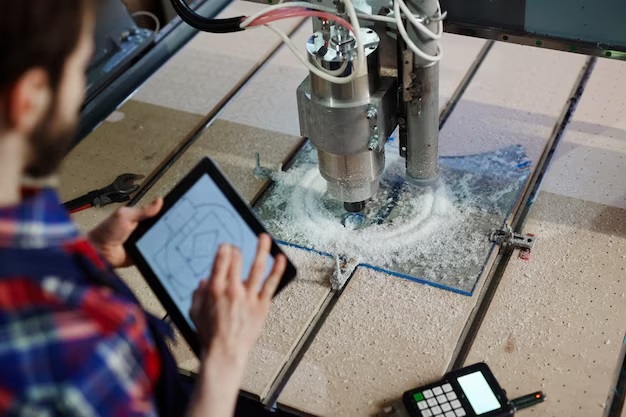In today’s dynamic industrial landscape, CNC manufacturing stands tall as a pivotal technology revolutionizing production processes. By integrating computerized controls into machining tools, CNC systems offer unparalleled precision, efficiency, and versatility. This guide will delve into the intricate world of CNC manufacturing, exploring its techniques, diverse applications, and far-reaching implications.
Understanding CNC Manufacturing
CNC, short for Computer Numerical Control, refers to the automated control of machining tools and 3D printers through computer programs. These programs dictate precise movements and actions, empowering machines to produce intricate parts and components with utmost accuracy. CNC systems have evolved significantly, incorporating advanced technologies to enhance manufacturing capabilities.
Evolution of CNC Technology
From its inception in the mid-20th century to the cutting-edge systems of today, CNC technology has undergone a remarkable evolution. Early systems were limited in capabilities, relying on basic commands for machining. However, advancements in computing power, software development, and machine design have propelled CNC manufacturing to new heights, enabling complex and multi-axis operations with utmost precision.
Components of CNC Systems
Machine Tools
CNC systems operate various machine tools, including lathes, mills, routers, and lasers. These tools, driven by computer commands, sculpt raw materials into finished products with exceptional accuracy. The integration of advanced tooling and automated processes has elevated the efficiency and quality of machining operations.
Control Units
Control units serve as the brain of CNC systems, interpreting programming instructions and translating them into precise movements and actions. These units have evolved to handle intricate algorithms and real-time adjustments, ensuring optimal performance and accuracy.
Software
Sophisticated software programs generate CNC code, enabling designers and engineers to create intricate designs and instructions for manufacturing processes. Modern software incorporates advanced CAD (Computer-Aided Design) and CAM (Computer-Aided Manufacturing) functionalities, facilitating seamless communication between design and production stages.
Techniques in CNC Manufacturing
CNC Machining
Milling
Milling involves rotating cutting tools to remove material from a workpiece, creating complex shapes and features with high precision. This technique encompasses various methods, such as face milling and end milling, enabling the production of intricate components used across industries.
Turning
Turning operations rotate the workpiece while a cutting tool shapes it, ideal for cylindrical or spherical components. With advancements in CNC technology, turning processes have become highly automated, allowing for intricate designs and tight tolerances in production.
Grinding
Grinding operations utilize abrasive wheels to refine surfaces and achieve precise dimensions. CNC-controlled grinding machines ensure consistent and high-quality finishes for components requiring fine tolerances and surface smoothness.
CNC Routing
CNC routers carve materials like wood, plastic, and metal, employing precise cutting paths to create intricate designs and prototypes. These versatile machines cater to diverse industries, from woodworking to signage production, enabling precise and customizable outputs.
CNC Laser Cutting
Utilizing high-powered lasers, this technique precisely cuts or engraves materials with minimal waste and high accuracy. CNC-controlled laser cutting systems find applications in various industries, including metal fabrication, signage, and electronics manufacturing, due to their speed and precision.
Applications of CNC Manufacturing
Aerospace Industry
CNC technology plays a pivotal role in aerospace manufacturing, producing critical components like turbine blades with exacting precision. The use of advanced CNC techniques ensures lightweight yet durable parts that meet stringent aerospace standards.
Automotive Sector
From engine parts to intricate body components, CNC machining enhances efficiency and accuracy in automotive manufacturing. CNC technologies enable rapid prototyping and mass production of components, contributing to advancements in vehicle design and performance.
Medical Device Production
CNC techniques manufacture intricate medical devices and implants, ensuring precision and quality in healthcare technology. These technologies enable the production of customized and biocompatible components crucial for medical advancements.
Consumer Electronics
The sleek designs and intricate components of consumer electronics owe much to CNC manufacturing, enabling mass production of intricate parts. CNC technology ensures the production of intricate circuit boards, casings, and internal components with high precision and efficiency.
Advantages of CNC Manufacturing
Precision and Accuracy
CNC systems offer unmatched precision, consistently delivering components with microscopic tolerances. The ability to replicate designs with utmost accuracy ensures the production of high-quality parts meeting stringent specifications.
Increased Efficiency
Automated operations minimize human error and optimize production processes, enhancing overall efficiency. CNC manufacturing reduces material waste and cycle times, resulting in cost savings and improved productivity.
Versatility and Flexibility
CNC machines can produce a diverse range of parts and products, adapting quickly to design changes. This flexibility allows for rapid prototyping and efficient customization, catering to evolving market demands.
Conclusion
The world of CNC manufacturing is a testament to technological innovation, offering precision, efficiency, and versatility across various industries. Embracing CNC techniques propels industries toward greater productivity and higher-quality products, marking a transformative era in manufacturing.
